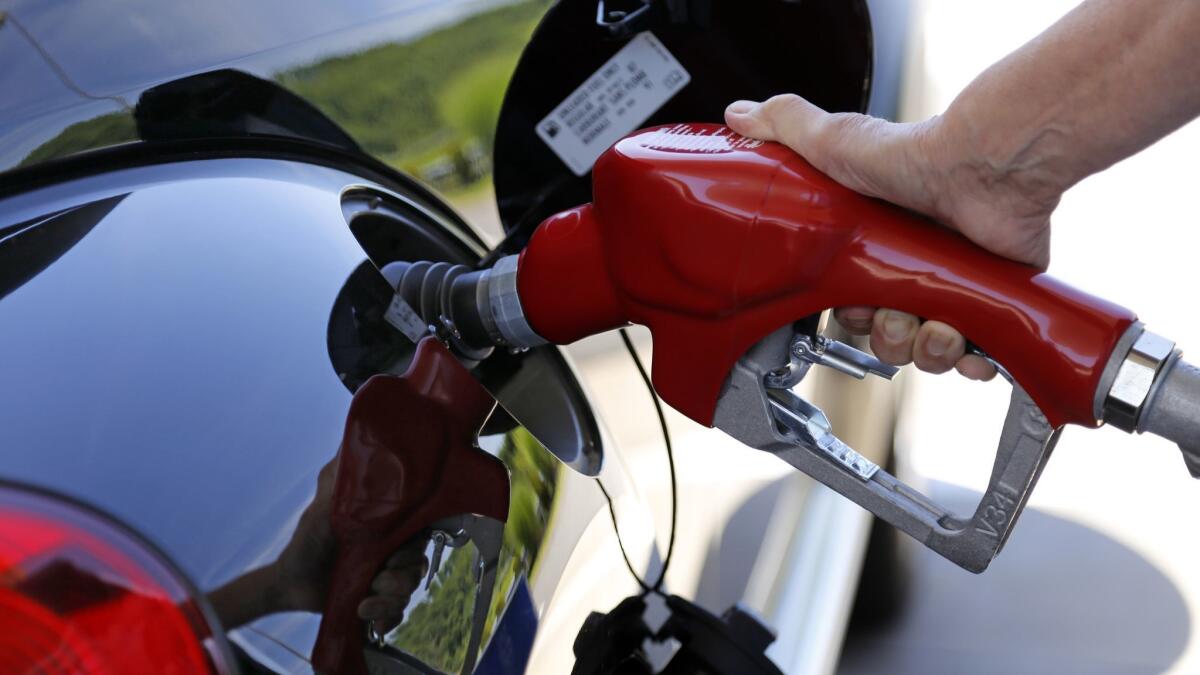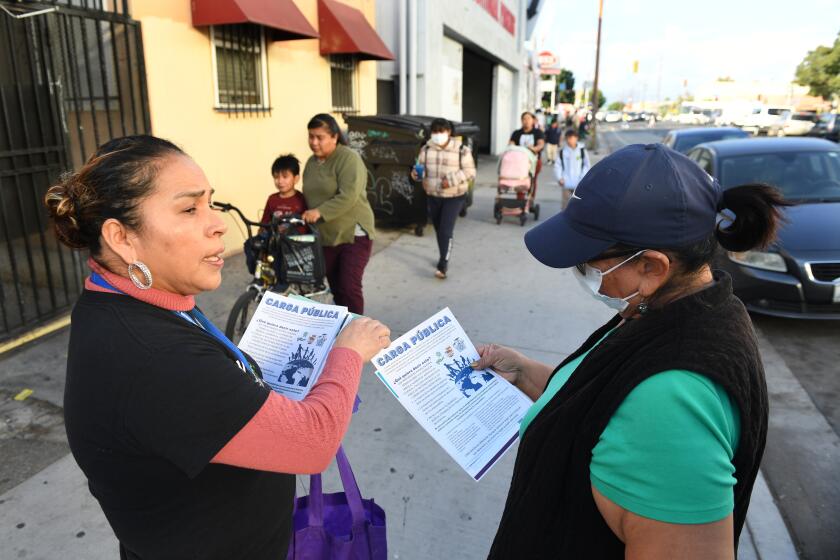Trump and California are set to collide head-on over fuel standards

- Share via
Reporting from Washington — The Trump administration is speeding toward all-out war with California over fuel economy rules for cars and SUVs, proposing to revoke the state’s long-standing authority to enforce its own, tough rules on tailpipe emissions.
The move forms a key part of a proposal by Trump’s environmental and transportation agencies to roll back the nation’s fuel economy standards. The agencies plan to submit the proposal to the White House for review within days.
The plan would freeze fuel economy targets at the levels required for vehicles sold in 2020, and leave those in place through 2026, according to federal officials who have reviewed it. That would mark a dramatic retreat from existing law, which aimed to get the nation’s fleet of cars and light trucks to an average fuel economy of 55 miles per gallon by 2025. Instead of average vehicle fuel economy ratcheting up to that level, it would stall out at 42 miles per gallon.
That would constitute the single biggest step the administration has taken to undermine efforts to combat climate change.
Cars and trucks recently surpassed electricity plants as America’s biggest sources of the greenhouse gases that drive global warming. And unlike the electricity industry, in which market forces have pushed utilities toward cleaner energy, including natural gas and renewable sources, relatively low gasoline prices in recent years have led consumers to pay less attention to fuel economy when they buy new cars.
As a result, the steady increase in fuel mileage standards championed by the Obama administration in partnership with California represented the most powerful action the U.S. has taken to reduce greenhouse-gas emissions. The biggest gains have been projected to happen in the years that the Trump administration’s plan would target.
The plan from the Environmental Protection Agency and the National Highway Traffic Safety Administration remains a draft, and White House officials could decide to back away from a direct fight with California and like-minded states.
Within the administration, officials have disagreed about how far and how quickly to push changes in fuel economy rules, according to officials familiar with the discussions. Some officials attuned to the concerns of the auto industry have warned against a proposal that over-reaches and could lead to years of litigation and uncertainty. Others, aligned with EPA chief Scott Pruitt, have argued for a more aggressive push.
EPA spokesperson Liz Bowman declined to comment on the details of the draft plan.
“The Agency is continuing to work with NHTSA to develop a joint proposed rule and is looking forward to the interagency process,” she wrote in an email.
Environmental groups and California officials already have vowed to fight the administration in court. But if the EPA plan prevails, it would be a crippling blow to efforts in California and other states to meet aggressive goals for climate action as well as for cleaning their air.
“I find this to be an outrageous intrusion,” Sen. Dianne Feinstein (D-Calif.) said in an email.
“California has its own authority under the Clean Air Act to continue the tough standards that are in place today. We will take this fight to the courts if the Trump administration challenges that authority,” she said. “This is going to have a real impact both on global warming and the air we breathe. It’s one bad move.”
Feinstein has successfully pushed in the Senate for bipartisan legislation for aggressive mileage targets.
Under federal law, California has long been allowed to set tougher tailpipe emission rules than the federal government. Other states are allowed to adopt California’s standards, and a dozen currently do. Those states account for more than a third of cars and trucks in the country.
The administration proposal would revoke the ability of any state, including California, to impose rules different from those made in Washington.
The rollback of mileage targets goes further even than the auto industry has sought, and it threatens to disrupt their business. The plan would be destined for years of costly litigation, creating uncertainty for carmakers.
“Rather than pursuing a reasonable compromise, the Trump administration is crafting a proposal that is dramatically weaker than any automobile manufacturer has requested and that also deliberately seeks to embark on a legal collision course with the state of California — a scenario that automakers, lawmakers and the state of California have all repeatedly urged the administration to avoid,” said Sen. Tom Carper (D-Del.), the senior Democrat on the Environment and Public Works Committee.
“If enacted, this proposal would be a loss for the environment, a loss for consumers, a loss for the state of California and a loss for the auto industry, which is why all parties must come together immediately to find a workable solution that we know is very much within reach,” he said.
Pruitt argues that the current fuel economy rules are unnecessary, rely on technology that has yet to be perfected and will raise auto prices too high for many consumers.
The program has “created these arbitrary [mileage] levels that have put a certain sector of cars in the marketplace which no one is purchasing,” he said in congressional testimony this week. Because of the cost, he said, consumers “stay in older vehicles, which defeats the purpose.”
Environmental and consumer advocacy groups strenuously dispute Pruitt’s characterization of the program, pointing to record car sales and increased automobile safety. Officials in California and the other states eager to keep the existing mileage targets in place point to thousands of pages of federal and state data and analysis confirming the targets are within reach and would benefit the economy.
They say the uneasiness with the EPA proposal even among auto companies should give the administration pause.
“It isn’t every century we and the auto companies agree on anything,” said Dan Becker, director of the Safe Climate Campaign. “But we appear to agree that what they are proposing here is a dreadful set of ideas.”
Officials at the California Air Resources Board, which oversees the state’s vehicle emissions program, said the administration has not yet shared the proposal with them.
“If enacted, this would harm people’s health, boost greenhouse gas pollution and force drivers to pay more money at the pump for years,” Stanley Young, spokesman for the board, said in an email. “It would also severely disrupt the U.S. auto industry, compromising its ability to succeed in a highly competitive global market that increasingly values innovative and efficient technologies.”
California has been in this fight with the federal government before, and it has prevailed. The administration of George W. Bush also resisted aggressive mileage targets the state sought. But the courts ultimately ruled that federal law required such action to combat climate change.
Testifying before Congress on Thursday, Pruitt assured lawmakers he does not plan to revoke the special waiver California was granted by the EPA that allows the state to set its own mileage targets.
What he didn’t say is that the proposal the EPA and NHSTA are poised to deliver to the White House would sidestep the waiver by relying on a different set of legal authorities to block California’s plans.
The administration’s legal case rests on the law, passed in the 1970s amid the OPEC oil embargo, that first created the country’s fuel economy standards.
Administration lawyers argue that the law gives NHTSA power to preempt California’s authority to set its own rules. NHTSA’s authority, according to the draft plan, supersedes the waiver the EPA has given California.
The auto industry began lobbying Trump to relax fuel economy standards soon after his election. But company officials have been clear that they want a deal with California, not a war with the state. In backroom negotiations, industry officials have urged the administration not to create a situation where California pursues one standard and the federal government pursues another.
Auto company representatives declined to talk on the record, but industry executives have asked for a meeting at the White House, where they will urge the administration to avoid a collision with California, according to people involved in the negotiations who spoke anonymously to comment on the private discussions.
The prospect of two different standards is a business dilemma for the companies, which want to build one fleet of vehicles for the entire nation. The possibility of the administration trying to force California to adhere to weaker federal rules creates a different kind of dilemma, one which could drag on for years and leave auto companies uncertain about what rules they should design their vehicles around.
“A long, litigious road is the worst outcome for all stakeholders, especially the auto industry and American consumers,” said Robbie Diamond, who leads Securing America’s Future Energy, a group of business and former military leaders trying to help broker a compromise.
More stories from Evan Halper »
Follow me: @evanhalper
UPDATES:
3 p.m.: This article was updated with comments from the California Air Resources Board and additional analysis.
12:20 p.m.: This article was updated with additional reaction to the administration proposal and analysis.
This article was originally published at 10:20 a.m.
More to Read
Get the L.A. Times Politics newsletter
Deeply reported insights into legislation, politics and policy from Sacramento, Washington and beyond. In your inbox twice per week.
You may occasionally receive promotional content from the Los Angeles Times.










